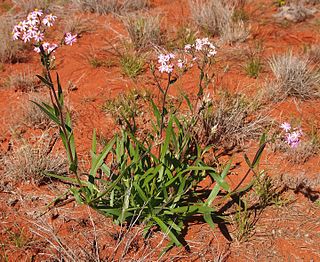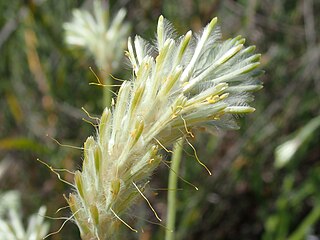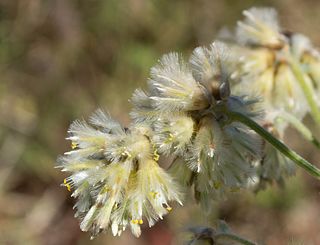
Scaevola is a genus of flowering plants in the Goodenia family, Goodeniaceae. It consists of more than 130 species, with the center of diversity being Australia and Polynesia. There are around 80 species in Australia, occurring throughout the continent, in a variety of habitats. Diversity is highest in the South West, where around 40 species are endemic.

Grevillea is a diverse genus of about 360 species of evergreen flowering plants in the family Proteaceae, native to rainforest and more open habitats in Australia, New Guinea, New Caledonia, Sulawesi and other Indonesian islands east of the Wallace Line. It was named in honour of Charles Francis Greville, an 18th century patron of botany and co-founder of the Royal Horticultural Society. The species range from prostrate shrubs less than 50 cm (20 in) tall to trees 35 m (115 ft) tall. Common names include grevillea, spider flower, silky oak and toothbrush plant. Closely related to the genus Hakea, the genus gives its name to the subfamily Grevilleoideae.

Leucopogon is a genus of about 150-160 species of shrubs or small trees in the family Ericaceae, in the section of that family formerly treated as the separate family Epacridaceae. They are native to Australia, New Zealand, New Caledonia, the western Pacific Islands and Malaysia, with the greatest species diversity in southeastern Australia. Plants in this genus have leaves with a few more or less parallel veins, and tube-shaped flowers usually with a white beard inside.

Rhodanthe, also known as sunray or pink paper daisy, is a genus of Australian plants in the pussy's-toes tribe within the daisy family.

Isopogon, commonly known as conesticks, conebushes or coneflowers, is a genus of about forty species of flowering plants in the family Proteaceae, and are endemic to Australia. They are shrubs with rigid leaves, bisexual flowers in a dense spike or "cone" and the fruit is a small, hairy nut.

Ozothamnus is a genus of plants found in Australia, New Zealand and New Caledonia.

Halgania is a genus of small shrubs in the family Boraginaceae. The genus comprises about 20 species that are endemic to Australia. Halgania is named for Emmanuel Halgan, a vice-admiral in the French Navy.

Ptilotus R.Br. is a genus of approximately 120 species of annual and perennial herbs and shrubs in the family Amaranthaceae. All species are native to mainland Australia, although one species, Ptilotus spathulatus (R.Br.) Poir., also occurs in Tasmania and another, Ptilotus conicus R.Br., in Malesia on the islands of Flores and Timor. Most of the diversity is in Western Australia, particularly in the Pilbara. Common names for species in this genus include mulla mulla, foxtails, pussy tails and lamb's tails. The genus was first formally described by botanist Robert Brown in Prodromus Florae Novae Hollandiae in 1810. In family-level phylogenetic studies, Ptilotus has been placed within a clade informally known as the 'aervoids'. It has been resolved as monophyletic and is closely related to Aerva Forssk. An interactive key to the species of Ptilotus is available at KeyBase.

Phaleria is flowering plant genus of about 20 species in the family Thymelaeaceae.

Schoenia is a genus of Australian plants in the pussy's-toes tribe within the daisy family.

Adenanthos detmoldii, commonly known as Scott River jugflower or yellow jugflower, is a species of shrub in the family Proteaceae. It is endemic to the south-west of Western Australia.

Ptilotus manglesii, commonly known as pom poms is a herb native to Western Australia. The Noongar name for the plant is mulla mulla.

Ptilotus rotundifolius(F.Muell.) F.Muell. is a pink-flowered species of shrub in the genus PtilotusR.Br. (Amaranthaceae). It is commonly known as "royal mulla mulla". It is native to the Gascoyne, Murchison and Pilbara IBRA regions of Western Australia.

Ptilotus polystachyus is a grass-like plant in the Amaranthaceae family.

Ptilotus schwartzii is a grass-like plant in the Amaranthaceae family.

Ptilotus divaricatus is a grass-like plant in the Amaranthaceae family.

Ptilotus auriculifolius is a grass-like plant in the Amaranthaceae family.

Ptilotus humilis is an annual herb in the Amaranthaceae family, native to Western Australia. It was first described as Trichinium humile by Nees von Esenbeck in 1845 but was transferred to the genus, Ptilotus, by Ferdinand von Mueller in 1868.



















